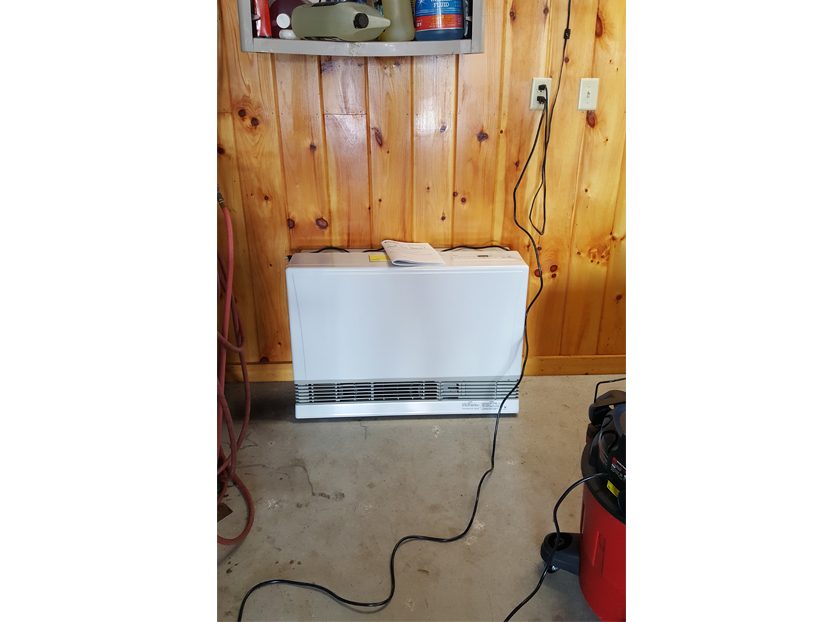Educating the Old School
Heating a garage after the fact.

One day I got a call from one of my best customers. He tells me, “My uncle wants to get his garage heated. Is there anything you can do to help him out?”
“Sure,” I replied. “I can do that. What is he looking for?”
He just wants heat; he wants something that is quiet and will keep the garage comfortable. He hosts occasional family gatherings in the garage and needs something that doesn’t require family members to shout at each other whenever the heat turns on.
“Got it,” I replied. “I’ll need to get over there and do a heat load calculation.”
“What for?” he asked. “The building is 40 feet by 40 feet. Isn’t that all you need to know?”
“Sorry, no. I need to look at the building and determine all the R-values of the shell and construction type to do an accurate heat load calculation to properly size the heating equipment.”
See this guy, historically, was used to contractors just sizing heating and cooling equipment based on the square footage of the building. There is entirely too much of that being done by both large and small companies. They use a “rule of thumb” for this method. They calculate the square feet (sf) of conditioned floor space, and multiply it by X number of BTUs/sf. X equals whatever they feel is appropriate. This is an incredible disservice to not only the consumer, but to the industry as a whole. This method is basically a guess and ends up with oversized equipment 99 percent of the time. But, sooner or later, they install equipment that is undersized and cannot keep the space warm. Having to deal with a travesty such as this, and never wanting to again, they add an additional 5 BTUs/sf to their multiplier. Now they end up with grossly oversized equipment 99 percent of the time.
A salesman from one of my suppliers told me that when it comes to sizing boilers, the majority of contractors will send him a picture of the data plate on the boiler and ask for a boiler that matches the BTU output of the current one. That’s why we sometimes walk in on a fairly new five section boiler in a house that only takes 30,000 BTU/H on the coldest day of the year, with the doors hanging open.
Having been doing heat load calculations for years, I have found that the number of BTUs/sf required to heat a space varies wildly. The only way to get an accurate number is to do an actual heat load calculation. Most customers are willing to pay for your time to do it once you explain to them what it is you are doing, and how it will benefit them.
Back to the task at hand.
“Ok,” he replied. “If you think that’s what we need to do. Just give me a call when you are ready, and I’ll meet you there. My uncle is in Florida right now.
“By the way,” he continued. “This guy has more money than both me and you put together. But he doesn’t like to spend any of it. He’s from the old school.”
So we have a tough customer that is family with one of my best customers. That can turn into a bad situation if one isn’t careful.
A few days later, I met him at his uncle’s garage. It was as he had said. The guy lived in a mobile home but had a beautiful garage filled with classic cars. The inside of the garage was lined with stained knotty pine wood while the outside was a neatly trimmed metal facade. Some of the cars must have been worth more than my house!
I gawked at the cars for a while before getting to work. How could you not?
I completed the heat load, and it came in around 33,000 BTU/h. Given the low noise requirements for the space, I decided to go with a Rinnai modulating wall furnace. They are perfect for areas like this. My first choice for garages like this is radiant slab heating, but you can’t very well install a radiant system when the concrete is already poured. The Rinnai wall furnace proved to be the next best option. I have been very pleased with its performance, as is the customer.
Once I had a proposal for the installation prepared, I presented it to the uncle. He looked over it a little bit and said, “I’ll give you the job if you take $200 off the price.” That was the old school wheeler-dealer side of him coming out. Every purchase must be a deal.
I hate that! You do too.
But he was family to my best customer, so I agreed reluctantly. We shook hands, and the deal was made. That was his way of doing business. No contracts; just a handshake is needed to make a deal.
This unit would have to run on propane since natural gas was unavailable at his residence, and that opened up a can of worms. He fretted and fussed trying to find the cheapest possible solution to get a propane tank. He called me up, and asked me to ride along over to one of his farms. He said, “I have a 500-gallon tank over there that is no longer being used. It used to be connected to a grain bin dryer, but the grain bin has since been torn down.”
Once again, I reluctantly agreed to do that.
I met him at his house, jumped in his car and headed over to the farm. He was nice, old fellow in spite of his frugal nature. He drove me all over the countryside showing me this farm and that one. He owned a bunch of them, and I think I got to see them all. The whole time he is telling stories of yesteryear. He gave me a detailed history of how he and his brother started the Ford dealerships in the area.
It was all very interesting to me; however, it was also becoming increasingly clear that I wasn’t going to make a dime on this job.
After driving all over creation, we finally came to the farm with the discarded propane tank. It was lying there on its side in an old, rusty heap. The tank ports were not capped, which meant the rust on the inside of the tank was just as bad as the outside. It was so old that if the Pilgrims had propane, I would put money on it that this was one of the tanks that they used.
Now, I had the delicate task of persuading him that we could not use this tank because of all the rust. It wouldn’t be safe at all.
He was extremely disappointed but, after much ado, I managed to gently persuade him that buying a new 100-gallon tank would be a much better solution.
So back to his place we went, once more taking every detour and exploring the countryside. All told, by the time we got back, I lost at least half of a work day. This job was definitely in the red at this point, but somehow I found myself enjoying it.
After a few days, he gives me call and informs me that he got a propane tank and is ready to have his heater installed.
On the day of the install, he was there and ready to be of assistance or to just get in the way. It was a rather slow process because I had to take the time to explain almost every move I made. He wasn’t being hateful; he just wanted to know what was going on.
But with all that, I finally got it installed and turned on. They really are a snap to install. You only need two wall penetrations, and the unit hides both. One hole for the direct vented exhaust and one hole to bring in the gas line. The packaging box serves as double duty, also acting as a template to mount the heater brackets and drill the wall penetrations. The exhaust vent has a telescoping piece that accommodates a variety of different wall thicknesses. After you get the vent and gas line installed, you simply plug in the furnace and turn it on.
The furnace pulls its return air from both sides of the heater down to two inches off floor level. It has a return air temperature sensor that controls the modulation rate of the furnace. The further it gets away from the user selected setpoint, the higher the burner operates. The air is then heated and blown out of the front of the heater about five inches off floor level. The front has adjustable louvers to allow the air to be blown out into the room in a fan-shaped pattern. The modulating burner allows very tight temperature control of the room, increasing comfort and efficiency. With a standard furnace and a non-modulating burner, the air has a set temperature increase between the return and supply. This often creates a large disparity in room temperature between the floor and ceiling — that is inefficient and uncomfortable. The Rinnai wall furnace, on the other hand, constantly circulates the air and gently heats it as needed. This creates a much more even temperature between the floor and ceiling.
After I had everything done and buttoned up, I gave him the bill, and he paid me on the spot. That was his way. He said, “I think I’m going to clear some wall space over on the side of the garage to put the second heater in. I can kind of see already that this one isn’t big enough to heat the garage. Old school.”
“Well,” I replied, “don’t be too hasty. This heater will heat the garage just fine.”
But he didn’t believe me. He set a thermometer out there to monitor the temperature.
I heard nothing out of him after that until the next spring. His nephew called me one day and said, “My uncle was just here bragging about his garage heater. He said it made no noise, kept the room right on temp all winter long and hardly used any gas. He is pleased as punch!”
We are always happy to hear feedback like this!
I also learned something through this job: old school cannot be educated through telling. It has to be educated through showing.





